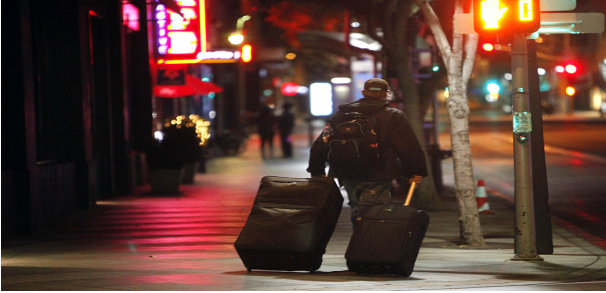MAILANDER’S LA-These days, when I walk the boulevards of Hollywood, I often see homeless and indigent types being coaxed by guards hired by business improvement districts to get up off the sidewalk and to start on their way to somewhere else. But where are they heading?
A report from a woman in the Valley says that on Veteran's Day, those homeless who "congregate at the Van Nuys Courthouse Mall in front of the Van Nuys Police Station were arrested" and held in jail for two days.
"These people congregate there every day in what they consider a safe area with free WI FI, a park like setting, and, until then, police protection. They all leave by 7:00 P.M. every night. What kind of compassionate city is Los Angeles that wages war on the homeless?" she asks.
On the eve of Thanksgiving, the New York Times' Adam Nagourney reported that LA City Council, led by Hollywood's Tom LaBonge, is pondering a ban on feeding the homeless in public spaces. He especially has Hollywood in mind. "By 6:30 p.m., more than 100 homeless people had lined up at a barren corner in Hollywood, drawn by free meals handed out from the back of a truck every night by volunteers," the report began.
If homelessness is privately and now perhaps publicly being pushed out of Hollywood and LA's South Bay, it appears to be being pushed into the San Fernando Valley.
"The numbers of homeless men, women and children increased sharply in the San Fernando and Antelope valleys in the last two years but have decreased in some parts of the county, including in the South Bay, according to figures released over the summer by LAHSA," the LA Daily News reported this week. "In the San Fernando Valley, there were 7,790 homeless found this year, compared with 4,837 counted in 2011”--another staggering jump.
In Sunland-Tujunga, Councilmember Felipe Fuentes continues to run a secretive "Sunland-Tujunga Homeless Issues Working Group" in which church volunteers talk to City and County agencies about--well, who knows what about?
Originally spearheaded by Paul Krekorian and ramped up by Richard Alarcon, Fuentes' staffers have flip-flopped regarding the public status of the group for nearly six months now. Fuentes' Council office first would not release the names of those invited to the secretive group, then said the public or at minimum interested community stakeholders would be notified of the group's meetings, then reversed itself yet again.
The Sunland-Tujunga Homeless Issues Working Group has abundant incentive to continue its ostrich-like relationship to the public even in the face of an obviously increasing community and regional problem.
For administrators and redevelopment lobbyists alike, the stakes regarding how to handle the homeless at the regional level remain high. Many top administrators in the affordable housing/homeless industrial complex make well above six figures; construction contracts for new, expensive homeless housing projects have been generous. But only a select handful of homeless typically benefit from a steel and concrete housing complex or shelter hooked up with the latest solar panels.
While the top administrators complain that the Federal government doesn't do enough, activists complain that not enough progress has been made in Los Angeles County compared to the money spent on the programs across the past two decades.
And the two decades' of investment in Los Angeles has been far from fruitful. According to a recent Housing and Urban Development report on homelessness, homelessness has decreased nearly everywhere in the United States--excepting New York City and Los Angeles. For all the spending across the decades, in Los Angeles County 53,000 people were found to be homeless in early 2013, nearing an all-time high.
And Los Angeles also had the second highest rate of unsheltered homeless in the nation, a shocking 76% of all homeless, second only to the area around the immigrant communities of Fresno.
Whether or not local agencies, after twenty years of aggressive private and public fundraising, are truly working to solve the problem or are working to curry political favor remains an enormous concern of the activists who monitor homeless programs. But one thing is certain: a good portion of those homeless in Hollywood and the South Bay are being encouraged to find services elsewhere.
The same thing happens at parks in the north and northeast Valley nearly every weekend--and the discussion about how and why it happens is kept out of public scrutiny. But in Hollywood, where successful redevelopment has brought crowds and tourists back in large numbers, the homeless, while still prevalent, are very definitely not as visible as they once were.
And in the San Fernando Valley, especially from Van Nuys to points east, they are more visible than ever. It's not hard to connect these dots.
(Joseph Mailander is a writer, an LA observer and a contributor to CityWatch. He is also the author of Days Change at Night: LA's Decade of Decline, 2003-2013. Mailander blogs here.)
-cw
Tags:
CityWatch
Vol 11 Issue 96
Pub: Nov 29, 2013





